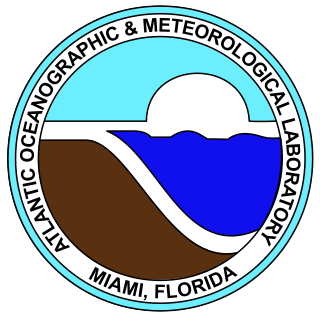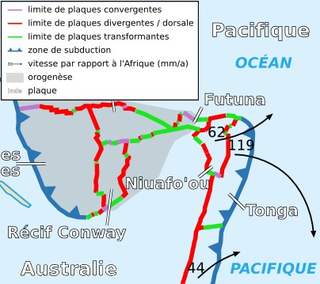External links
| | This climatology/meteorology–related article is a stub. You can help Wikipedia by expanding it. |
The Parallel Ocean Program (POP) is a three-dimensional ocean circulation model designed primarily for studying the ocean climate system. The model is developed and supported primarily by researchers at LANL.

In geology, a supercontinent is the assembly of most or all of Earth's continental blocks or cratons to form a single large landmass. However, some earth scientists use a different definition, "a grouping of formerly dispersed continents", which leaves room for interpretation and is easier to apply to Precambrian times although at least about 75% of the continental crust then in existence has been proposed as a limit to separate supercontinents from other groupings.
Geochemistry is the science that uses the tools and principles of chemistry to explain the mechanisms behind major geological systems such as the Earth's crust and its oceans. The realm of geochemistry extends beyond the Earth, encompassing the entire Solar System, and has made important contributions to the understanding of a number of processes including mantle convection, the formation of planets and the origins of granite and basalt. It is an integrated field of chemistry and geology.

Oceanography, also known as oceanology, is the scientific study of the ocean. It is an important Earth science, which covers a wide range of topics, including ecosystem dynamics; ocean currents, waves, and geophysical fluid dynamics; plate tectonics and the geology of the sea floor; and fluxes of various chemical substances and physical properties within the ocean and across its boundaries. These diverse topics reflect multiple disciplines that oceanographers utilize to glean further knowledge of the world ocean, including astronomy, biology, chemistry, climatology, geography, geology, hydrology, meteorology and physics. Paleoceanography studies the history of the oceans in the geologic past. An oceanographer is a person who studies many matters concerned with oceans including marine geology, physics, chemistry and biology.

An ocean current is a continuous, directed movement of sea water generated by a number of forces acting upon the water, including wind, the Coriolis effect, breaking waves, cabbeling, and temperature and salinity differences. Depth contours, shoreline configurations, and interactions with other currents influence a current's direction and strength. Ocean currents are primarily horizontal water movements.

Within the atmospheric sciences, atmospheric physics is the application of physics to the study of the atmosphere. Atmospheric physicists attempt to model Earth's atmosphere and the atmospheres of the other planets using fluid flow equations, chemical models, radiation budget, and energy transfer processes in the atmosphere. In order to model weather systems, atmospheric physicists employ elements of scattering theory, wave propagation models, cloud physics, statistical mechanics and spatial statistics which are highly mathematical and related to physics. It has close links to meteorology and climatology and also covers the design and construction of instruments for studying the atmosphere and the interpretation of the data they provide, including remote sensing instruments. At the dawn of the space age and the introduction of sounding rockets, aeronomy became a subdiscipline concerning the upper layers of the atmosphere, where dissociation and ionization are important.

The Weather Prediction Center (WPC), located in College Park, Maryland, is one of nine service centers under the umbrella of the National Centers for Environmental Prediction (NCEP), a part of the National Weather Service (NWS), which in turn is part of the National Oceanic and Atmospheric Administration (NOAA) of the U.S. Government. Until March 5, 2013 the Weather Prediction Center was known as the Hydrometeorological Prediction Center (HPC). The Weather Prediction Center serves as a center for quantitative precipitation forecasting, medium range forecasting, and the interpretation of numerical weather prediction computer models.

The Atlantic Oceanographic and Meteorological Laboratory (AOML), a federal research laboratory, is part of National Oceanic and Atmospheric Administration's (NOAA) Office of Oceanic and Atmospheric Research (OAR), located in Miami, Florida. AOML's research spans tropical cyclone and hurricanes, coastal ecosystems, oceans and human health, climate studies, global carbon systems, and ocean observations. It is one of seven NOAA Research Laboratories (RLs).
The Modular Ocean Model (MOM) is a three-dimensional ocean circulation model designed primarily for studying the ocean climate system. The model is developed and supported primarily by researchers at the National Oceanic and Atmospheric Administration's Geophysical Fluid Dynamics Laboratory (NOAA/GFDL) in Princeton, NJ, USA.

The Lunar Magma Ocean (LMO) is the layer of molten rock that is theorized to have been present on the surface of the Moon. The Lunar Magma Ocean was likely present on the Moon from the time of the Moon's formation to tens or hundreds of millions years after that time. It is a thermodynamic consequence of the Moon's relatively rapid formation in the aftermath of a giant impact between the proto-Earth and another planetary body. As the Moon accreted from the debris from the giant impact, gravitational potential energy was converted to thermal energy. Due to the rapid accretion of the Moon, thermal energy was trapped since it did not have sufficient time to thermally radiate away energy through the lunar surface. The subsequent thermochemical evolution of the Lunar Magma Ocean explains the Moon's largely anorthositic crust, europium anomaly, and KREEP material.
A helium release valve, helium escape valve or gas escape valve is a feature found on some diving watches intended for saturation diving using helium based breathing gas.
The Princeton Ocean Model (POM) is a community general numerical model for ocean circulation that can be used to simulate and predict oceanic currents, temperatures, salinities and other water properties.

The Ocean Prediction Center (OPC), established in 1995, is one of the National Centers for Environmental Prediction's (NCEP's) original six service centers. Until 2003, the name of the organization was the Marine Prediction Center. Its origins are traced back to the sinking of the RMS Titanic in 1912. The OPC issues forecasts up to five days in advance for ocean areas north of 31° north latitude and west of 35° west longitude in the Atlantic, and across the northeast Pacific north of 30° north latitude and east of 160° east longitude. Until recently, the OPC provided forecast points for tropical cyclones north of 20° north latitude and east of the 60° west longitude to the National Hurricane Center. OPC is composed of two branches: the Ocean Forecast Branch and the Ocean Applications Branch.

A continent is one of several large landmasses. Generally identified by convention rather than any strict criteria, up to seven regions are commonly regarded as continents. Ordered from largest in area to smallest, these seven regions are: Asia, Africa, North America, South America, Antarctica, Europe, and Australia. Variations with fewer continents may merge some of these, for example some systems include Eurasia or America as single continents.

The Niuafo'ou Plate is a small tectonic plate located west of the islands of Tonga. This plate is sandwiched between the Pacific Plate to the north, the very unstable Tonga Plate to the east and the Australian Plate to the west. It is primarily surrounded by convergent boundaries. This plate is riddled with active faults thus making the area extremely earthquake prone.
James C. McWilliams is a professor at the UCLA Institute of Geophysics and Planetary Physics and Department of Atmospheric and Oceanic Sciences.

An ice planet is a theoretical type of exoplanet with an icy surface of volatiles such as water, ammonia, and methane. Ice planets consist of a global cryosphere. They are bigger versions of the small icy worlds of the Solar System, which includes the moons Europa, Enceladus, and Triton, the dwarf planets Pluto and Eris, and many other small Solar System bodies such as comets. In June 2020, NASA scientists reported that it is likely that exoplanets with oceans, including some oceans that may be frozen, may be common in the Milky Way galaxy, based on mathematical modeling studies.
Ocean general circulation models (OGCMs) are a particular kind of general circulation model to describe physical and thermodynamical processes in oceans. The oceanic general circulation is defined as the horizontal space scale and time scale larger than mesoscale. They depict oceans using a three-dimensional grid that include active thermodynamics and hence are most directly applicable to climate studies. They are the most advanced tools currently available for simulating the response of the global ocean system to increasing greenhouse gas concentrations. A hierarchy of OGCMs have been developed that include varying degrees of spatial coverage, resolution, geographical realism, process detail, etc.

The Finite Volume Community Ocean Model is a prognostic, unstructured-grid, free-surface, 3-D primitive equation coastal ocean circulation model. The model is developed primarily by researchers at the University of Massachusetts Dartmouth and Woods Hole Oceanographic Institution, and used by researchers worldwide. Originally developed for the estuarine flooding/drying process, FVCOM has been upgraded to the spherical coordinate system for basin and global applications.
The UBC Institute for the Oceans and Fisheries (IOF) is a research unit at the University of British Columbia (UBC) that was formed in 2015 by incorporating members from the former UBC Fisheries Centre, as well as a subset of researchers that are conducting marine related research at UBC. Members of the IOF are drawn primarily from the Departments of Earth, Ocean and Atmospheric Sciences, Zoology and Botany. The UBC Institute for the Oceans and Fisheries brings together a community of Canadian and international experts in ocean and freshwater species, systems, economics, and issues to provide new insights into how global marine systems function, and the impacts of human activity on those systems. It is working towards a world in which the oceans are healthy and their resources are used sustainably and equitably. IOF is located at The University of British Columbia, and promotes multidisciplinary study of aquatic ecosystems and broad-based collaboration with researchers, educators, maritime communities, government, NGOs, and other partners.
Ridge push or sliding plate force is a proposed driving force for plate motion in plate tectonics that occurs at mid-ocean ridges as the result of the rigid lithosphere sliding down the hot, raised asthenosphere below mid-ocean ridges. Although it is called ridge push, the term is somewhat misleading; it is actually a body force that acts throughout an ocean plate, not just at the ridge, as a result of gravitational pull. The name comes from earlier models of plate tectonics in which ridge push was primarily ascribed to upwelling magma at mid-ocean ridges pushing or wedging the plates apart.